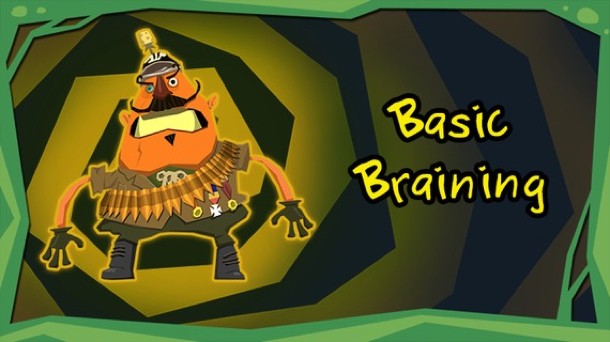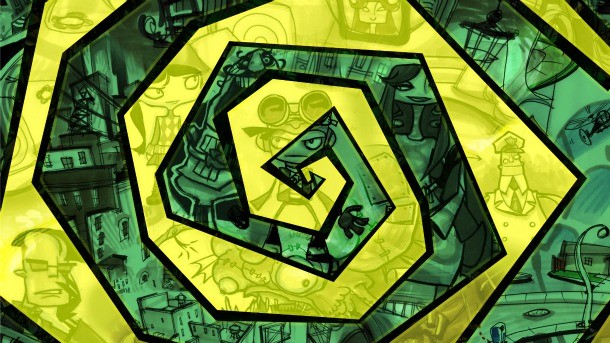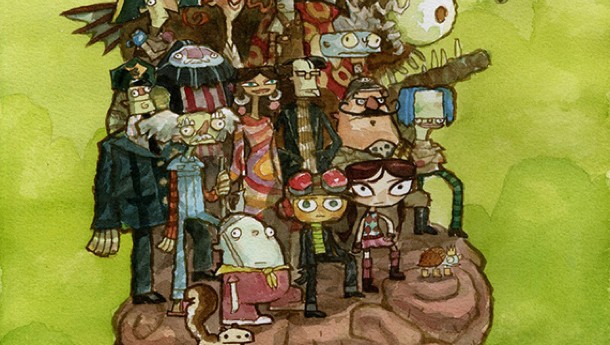Our extra-large special edition is here. Subscribe today and receive the 25% longer issue at no extra cost!
Thinking Of Investing In Psychonauts 2? Here Are Some Things To Know

Ever since its release in 2005, fans have been clamoring for a sequel to Double Fine's charming 3D platformer, Psychonauts. Last night at The Game Awards, Double Fine announced that it hopes to finally deliver a sequel, but it's going to need some help from fans.
Rather than pursue a traditional publishing arrangement like it had with Majesco a decade ago, Double Fine is following its trend of crowdfunding. This time, it'll be using the new Fig platform, which includes Double Fine's Tim Schafer, Obsidian’s Feargus Urquhart, inXile’s Brian Fargo, and Harmonix’s Alex Rigopolus on the advisory board. Fig is different than Kickstarter because it only features one game at a time and also allows investment in addition to traditional backing.
The campaign is off to a strong start, bringing in more than $1 million from investors and traditional backers in the first 24 hours. It also marks the first time non-accredited investors (those who don’t have a net worth of at least $1 million and earn more than $200,000 per year) can earn a return should they choose. For those that don’t meet the lofty accreditation requirements, for the first time, investment opportunities are available between $1,000 and $10,000. The amount you're legally allowed to invest is based on a calculation that takes into account your net worth and annual income.

So how does this program work?
In order to assist new, non-accredited investors understand how the system works, there’s a calculator featured on the site (and pictured immediately above). There, you can play around with the wholesale price (the revenue Double Fine will earn on a copy sold via a digital distributor).
The calculator defaults to a wholesale of $21. Multiple developers and publishers tell us that a unit wholesale price represents 70 percent of consumer sale price on Steam and console storefronts. Double Fine affirmed this estimation, but also pointed out that it isn't implying that Psychonauts 2 will be sold at launch for $30.
"The retail price of the game will be higher than the $40 price point we're offering in our Fig campaign," says Double Fine's Greg Rice. "That $21 wholesale price the calculator defaults to is a number Fig provides that is based on industry standard pricing for a game of Psychonaut's size over the first few years of its lifetime."
If Psychonauts is priced at $40, wholesale jumps to $28. If Double Fine opts for a full $60 price tag, each copy will contribute $42.
How much can I earn by investing?
In order for an investor to break even, Double Fine needs to sell 693,638 copies at the average wholesale price of $21. Rice says that amount essentially takes into account an average sale price of $30 inclusive of bundling and discounts that are industry standard. In other words, when you find a game in the physical or virtual "bargain bin," the situation is more complicated than the retailer or storefront simply reducing the price. The impact is most often incurred by the developer for digital copies and even for boxed copies it can be spread back up the supply channel.
Once the project does break even, the sky is essentially the limit. After the game becomes profitable, a $500 investment is going to earn $1 for every $68,376 of adjusted gross revenue (total revenue minus shipping and handling, taxes, customer returns, etc.). Calculated out, it amounts to $0.00000146 earned per $1 of adjusted gross revenue.
One of the ways Double Fine is using to instill confidence in investors about hitting its revenue goals is using sales figures from the first Psychonauts game. That's where things start to get tricky.

What are the chances of the game becoming profitable?
It’s important to break down the Psychonauts sales numbers. Because once you do, you'll understand that every copy sold is not equal.
A total of 1,697,073 copies have been sold. In the first five years of the game’s life as a $50 title, only 479,312 copies were moved. And, given that time frame, it’s safe to say that not all of those were sold at full price.
Double Fine leans heavily on what happened in the last five years. During that time, 1,217,761 copies were sold. That looks like an enormous uptick, but there are a number of factors to consider.
Psychonauts first appeared in a Humble Bundle in 2012. That distribution mechanism accounts for 736,119 copies of the total 1.7 million. Multiple industry sources tell me that when they include a game in a Humble Bundle, they expect to earn about $1 per copy.
When you grab a Humble Bundle full of seven games for under $10 and move the sliders around to give money to charity and to Humble too, you're setting the wholesale price for your copies. It's a calculated piece of the bundle deal, so developers and publishers know what they're in for, but it does have a profound impact.
Double Fine also lists 430,141 Steam copies, 23,368 Humble Store copies, and 32,000 GoG copies sold. Psychonauts has been discounted multiple times on these platforms and now retails for $9.99.
Even at that price, there are some who are still waiting for the next sale. And since that's always just around the corner, the next discount isn't hard to wait for. The translated wholesale right now on a copy of Psychonauts is about $7.
Currently, there are more than 8,500 backers eligible for a reward copy of Psychonauts 2. With each new backer at the $39 level (the $33 early bird level is now closed), that’s another copy of the game that won’t yield that wholesale price (or any wholesale price for that matter). The more backers the game earns, the fewer Double Fine fans there will be to purchase the game at its retail price.
We put this information forward, not to dissuade you from investing. That is ultimately your decision, and Double Fine is feeling especially confident after the early success of the campaign.
"In general, we have a lot of faith in the potential for success with Psychonauts 2," Rice says. "You can never be certain, but we've watched as the fan base has grown over the past 10 years and feel the market is ready to embrace the game. That is only more evident now, with the early success of this campaign."
Unfortunately, Double Fine is unable to anticipate how long it will take to reach the break-even point and begin returning revenue shares to investors. Rice says that a strong launch window at a wholesale price greater than $21 would quicken the pace to that point. Given that projected release is a full two years away though, it's important to consider what you might be giving up by making a longer term investment.

Those are good odds, right?
In order to determine if investing in crowdfunding projects is a good idea, you need to have an understanding of what other options are out there. You also need to understand that there is a cost for tying your money up with a long-term investment like game development.
Opportunity cost is a key factor in understanding if an investment opportunity is worth taking. If you invest $500 in Psychonauts 2, that money is going to be unavailable for use for at least two years before you can even begin to hope for a return. Even if you invest that money safely (let's say in a money market - or a short-term loan made between lending institutions like banks - yielding one percent return annually), you're giving up $10 in earnings between now and December 2017 (which is about when Psychonauts 2 is scheduled to be released).
Now, let's say you want to go a bit bigger with an additional measure of risk. You could take that same $500 and put it in an equity fund (hypothetically, as many equity funds require slightly larger amounts to open an account). You can easily find stock-based equity funds (a collection of stocks managed by an institution so that investors can have their risk managed and not worry about a complex portfolio) earning five percent return. Some yield 10 percent or more. There is volatility in the market, of course. But when compared with the risk associated with game development, it's hard to suggest that equity funds are riskier.
If you invest in an account with five percent yield, you'll turn your $500 investment into approximately $52 in earnings (before taxes) in two years. At 10 percent, that jumps to more than $100 before taxes. Again, these scenarios all yield return before Psychonauts 2 even gets out the door. That can be extrapolated to a number of other crowdfunding campaigns that promise results two years down the road.
It's not an all-or-nothing proposition. Psychonauts will sell, and you will earn some of your investment back. The important things to note are that you won't start recovering your principle (the amount you invested) until the game ships. Between when the game ships and when it breaks even, you'll be suffering a loss that's greater than $0, but less than your initial investment. During that period, you'll still be at a relative loss compared to other investment methods.
Okay. Good to know. So what should I do?
While we aren't going to tell you whether you should or shouldn't invest in crowdfunding projects, we do have some recommendations. Do your research, ask questions of the project manager, and temper your expectations. It's going to be a while before you see a return and, if you are a non-accredited investor, you may not be the top priority.
A $500 investment might not draw the same level of care as a $25,000 investment or $100,000 buy-in. That's a matter of understanding who is offering the investment opportunity and, again, being reasonable about the challenges of the project and that things might go wrong on the road to completion.
There are certainly people making money off video game investment, but they're doing it with deeper knowledge and greater chance of return for the risk. Investment should not be taken lightly, but provided you understand the risks and opportunity cost, at least you'll be going in with open eyes.

Get the Game Informer Print Edition!
Explore your favorite games in premium print format, delivered to your door.
- 10 issues per year
- Only $4.80 per issue
- Full digital magazine archive access
- Since 1991







